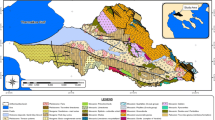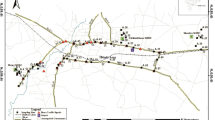Abstract
Mumbai metropolitan region (MMR) in India represents one of the most industrialized and thickly populated areas of the monsoon dominated Asian region. We present here pre- and post-monsoon magnetic susceptibility variations in the top-soils representing sampling domains of industrial, heavy traffic and forested areas within MMR. The rock magnetic studies (including isothermal and anhysteric remanent magnetization and hysteresis loop analysis) infer predominant pseudo single domain to multi domain grains in an overall ferrimagnetic dominant mineralogy of the soils. The susceptibility-temperature variations (from −190 to 700°C) infer maghemite (γ-Fe2O3) as the chief mineral component of pedogenic origin, and the pure magnetite (Fe3O4) is of anthropogenic nature. Spatial distribution of ferrimagnetic concentration is in agreement with polluting sources. The post-monsoon redistribution pattern is greatly controlled by the surface runoff and topographic conditions. The study demonstrates that in a ferrimagnetically reach substrate like MMR, the spatial distribution patterns derived from routine concentration- and grain-size-dependent rock magnetic parameters integrated with topographic and seasonal attributes yield significant information on the style and surface re-distribution of anthropogenically loaded soils and sediments to identify its seasonal dumping. Alternatively, knowing the source of signal, the magnetic susceptibility can be further used as a robust parameter to produce detailed maps to monitor the pollutions in urban areas.










Similar content being viewed by others
References
Beckwith PJ, Ellis D, Oldfield F (1986) Heavy metal and magnetic relationships for urban source sediments. Phys Earth Planet Int 42:67–75
Bityukova L, Scholger R, Birke M (1999) Magnetic susceptibility as indicator of environmental pollution of soil in Tallinn. Phys Chem Earth (A) 24:829–835
Blaha U, Basavaiah N, Deenadadayalan K, Borole DV, Mohite RD (2011) Onset of industrial pollution recorded in mumbai mudflat sediments, using integrated magnetic, chemical, 210Pb dating, and microscopic methods. Environ Sci Technol 45:686–692
Blavet D, Mathe E, Leprun JC (2000) Relations between soil colour and waterlogging duration in a representative hillside of the West African granito-gneissic bedrock. Catena 39:187–210
Bradshaw R, Thompson R (1985) The use of magnetic measurements to investigate the mineralogy of Icelandic lake sediments and study catchment processes. Boreas 14:203–215
Burt R (2004) Soil survey laboratory methods manual, Version No. 4.0 (USDA-NRCS Soil Survey Investigation Report No. 42). U.S. Government Printing Office, Washington, DC
Chaparro MAE, Gogorza CS, Lavat A, Pazos S, Sinito AM (2002) Preliminary results of magnetic characterization of different soils in Tandil region (Argentina) affected by the pollution of metallurgical factory. Eur J Environ Eng Geophys 7:35–58
Chaparro MAE, Bidegain JC, Sinito AM et al (2003) Preliminary result of magnetic measurements on stream sediments from Buenos Aires Province, Argentina. Stud Geophys Geod 47:53–77
Chaparro MAE, Bigegain JC, Sinito AM (2004) Magnetic studies applied to different environments (soils and stream sediments) from a relatively polluted area in Buenos Aires Province, Argentina. Environ Geol 45:654–664
Chaparro MAE, Chaparro MAE, Marinelli C, Sinito AM (2008) Multivariate techniques as alternative statistical tools applied to magnetic proxies for pollution: a case study from Argentina and Antarctica. Environ Geol 54:365–371
Collinson DW (1987) Methods in rock magnetism and palaeomagnetism: techniques and instrumentation. Chapman and Hall Publication, London
Day RM, Fuller, Shmidt VA (1977) Hysteresis properties of titanomagnetites: grain-size and compositional dependence. Phys Earth Planet Interiors 13:260–267
Dedik AN, Hoffmann P, Ensling J (1992) Chemical characterization of iron in atmospheric aerosols. Atmos Environ 26A:2545–2548
Dekkers MJ, Pietersen HS (1992) Magnetic properties of low-Ca fly ash: a rapid tool for Fe-assessment and a survey for potentially hazardous elements. Mater Res Soc Symp Proc 245:37–47
Deng CL, Zhu RX, Verosub KL, Singer MJ, Yuan BY (2000) Paleoclimatic significance of the temperature-dependent susceptibility of Holocene loess along a NW–SE transect in the Chinese loess plateau. Geophys Res Lett 27:3715–3718
Deng CL, Zhu RX, Jackson MJ, Verosub KL, Singer MJ (2001) Variability of the temperature-dependent susceptibility of the Holocene eolian deposits in the Chinese Loess Plateau: A pedogenesis indicator. Phys Chem Earth Part A 26:873–878
Deng CL, Zhu RX, Verosub KL, Singer MJ, Vidic NJ (2004) Mineral magnetic properties of loess/paleosol couplets of the central loess plateau of China over the last 1.2 Myr. J Geophys Res 109:B01103. doi:10.1029/2003JB002532
Draxier RR, Rolph GD (2003) HYSPLIT (HYbrid Single-Particle Lagrangian Integrated Trajectory) Model access via NOAA ARL READY. NOAA Air Resources Laboratory, Silver Spring, MD. http://www.arl.noaa.gov/HYSPLIT.php
Dunlop DJ, Ozdemir O (1997) Rock magnetism: fundamentals and frontiers. Cambridge University Press, Cambridge 573, pp 266–268
Durza O (1999) Heavy metals contamination and magnetic susceptibility in soils around metallurgical plant. Phys Chem Earth (A) 24(6):541–543
Evans ME, Heller F (2003) Environmental magnetism: principles and applications of enviromagnetics, vol 86. International Geophysics Series Academic press, Florida
Flanders PJ (1994) Collection, measurement, and analysis of airborne magnetic particulates from pollution in the environment. J Appl Phys 75(10):5931–5936
Georgeaud VM, Rochette P, Ambrosi JP, Vandamme D, Williamson D (1997) Relationship between heavy metals and magnetic properties in a large polluted catchment: the Etang de Berre (South of France). Phys Chem Earth 22(1–2):211–214
Goddu SR, Apple E, Jordanova D, Wehland F (2004) Magnetic properties of road dust form Vishakhapatanam (India)- relationship to industrial pollution and road traffic. Phys Chem Earth 29:985–995
Hanesch M, Scholger R (2002) Mapping of heavy metal loadings in soils by means of magnetic susceptibility measurements. Environ Geol 42:857–870
Hanesch M, Scholger R, Dekkers MJ (2001) The application of fuzzy C-means cluster analysis and non-linear mapping to a soil data set for the detection of polluted sites. Phys Chem Earth (A) 26:885–891
Hanesch M, Maier G, Scholger R (2003) Mapping heavy metal distribution by measuring the magnetic susceptibility of soils. J Phys IV France 107:605–608
Hansen J, Johnson D, Lacis A, Lebedeff S, Lee P, Rind D, Russell G (1981) Climate impact of increasing atmospheric carbon dioxide. Science 213(4511):957–966
Heller F, Strzyszcz Z, Magiera T (1998) Magnetic record of industrial pollution in forest soils of Upper Silesia, Poland. J Geophys Res 103:17767–17774
Heslop D (2009) On the statistical analysis of the rock magnetic S-ratio. Geophyc J Int 178:159–161
Hoffmann V, Knab M, Appel E (1999) Magnetic susceptibility mapping of roadside pollution. J Geochem 66(1–2):313–326
Hrouda F, Müller P, Hanak J (2003) Repeated progressive heating in susceptibility vs. temperature investigation: a new paleotemperature indicator? Phys Chem Earth 28:653–657
Hunt A, Jones J, Oldfield F (1984) Magnetic measurements and heavy metals in atmospheric particulates of anthropogenic origin. Sci Total Environ 33:129–139
Kapicka A, Petrovsky E, Ustjak S, Machackova K (1999) Proxy mapping of fly-ash pollution of soils around a coal-burning power plant: a case study in Czech Republic. J Geochem Explor 66:291–297
Kapicka A, Jordanova N, Petrovsky E, Ustjak S (2000) Magnetic stability of power-plant fly ash in different solutions. Phys Chem Earth (A) 25(5):431–436
Kapicka A, Jordanova N, Petrovsky E et al (2001) Low field susceptibility: a proxy method of estimating increased pollution of different environmental systems. Environ Geol 39(34):312–318
Liu QS, Deng CL, Yu Y, Torrent J, Jackson MJ, Banerjee SK, Zhu RX (2005) Temperature dependence of magnetic susceptibility in an argon environment: implications for pedogenesis of Chinese loess/palaeosols. Geophys J Int 161:102–112
Maher BA, Thompson R (1999) Quaternary climates environments and magnetism. Cambridge University Press, Cambridge
Maiti S, Narendra MK, Sangode SJ, Chakrapani GJ (2005) Magnetic susceptibility studies of soils in Delhi. J Geol Soc India 66:667–672
Meena NK, Maiti S, Shrivastava A (2011) Discrimination between anthropogenic (pollution) and lithogenic magnetic fraction in urban soils (Delhi, India) using environmental magnetism. J Appl. Geophys 73:121–129
Moskowitz BM (1981) Methods for estimating Curie temperatures of titanomaghemites from experimental Js-T data. Earth Planet Sci Lett 53:84–88
Mullender TAT, van Velzen AJ, Dekkers MJ (1993) Continuous drift correction and separate identification of ferrimagnetic and paramagnetic contributions in thermomagnetic runs. Geophys J Int 114:663–672
Munsell AH (2000) Munsell soil color charts: revised washable edition. GretagMacbeth, New Windsor, NY
Oches EA, Banerjee SK (1996) Rock-magnetic proxies of climate change from loess-paleosol sediments of the Czech Republic. Studia Geoph Geod 40:287–300
Oldfield F (1994) Towards the discrimination of fine grained ferrimagnets by magnetic measurements in lake and near-shore marine sediments. J Geophys Res 99:9045–9050
Peters C, Dekkers MJ (2003) Selected room temperature magnetic parameters as a function of mineralogy, concentration and grain size. Phy Chem Earth 28:659–667
Petrovsky E, Ellwood BB (1999) Magnetic monitoring of air-, land-, and water pollution. In: Maher BA, Thompson R (eds) Quaternary Climates, Environments and Magnetism. Cambridge University Press, Cambridge, pp s279–s322
Petrovsky E, Kapicka A, Zapletal K, Sebestova E, Spanila T, Dekkers MJ (1998) Correlation between magnetic parameters and chemical composition of lake sediments from northern Bohemia: preliminary study. Phys Chem Earth 23(9):1123–1126
Radhakrishnamurty C, Likhite SD, Deutsch ER, Murthy GS (1981) A comparison of the magnetic properties of synthetic titanomagnetites and basalts. Phys Earth Planet Interiors 26:37–46
Rolph GD (2003) Real-time environmental applications and display system (READY). http://www.arl.noaa.gov/ready.php. NOAA Air Resources Laboratory, Silver Spring, MD
Sangode SJ, Vhatkar K, Patil SK, Meshram DC, Pawar NJ, Gudadhe SS, Badekar AG, Kumarvel V (2010) Magnetic susceptibility distribution in the soils of Pune Metropolitan Region: Implication to soil magnetometry of anthropogenic loading. Curr Sci 98(4):516–527
Sehgal J, Challa O, Vadivelu S, Deshmukh SN (1996) Maharashtra soils NBSS-LUP, Government of India
Soil Survey Staff (1999) Soil taxonomy: a basic system of soil classification for making and interpreting soil surveys, 2nd edn. US Department of Agriculture Soil Conservation Service, Washington, DC
Stacey FD, Banerjee SK (1974) The physical principles of rock magnetism. Elsevier, Amsterdam
Stober JC, Thompson R (1979) An investigation into the source of magnetic minerals in some Finnish lake sediments. Earth Planet Sci Lett 45:464–474
Strzyszcz Z, Magiera T (1993) Distribution of ferromagnetics in forest soils of some Polish and German regions in relation to their origin. Mitteilungen der Deutschen Bodenkundlichen Gesellschaft 72:1309–1312
Sun WW, Banerjee SK, Hunt CP (1995) The role of maghemite in the enhancement of magnetic signal in the Chinese loess-paleosol sequence: An extensive rock magnetic study combined with citrate-bicarbonatedithionite treatment. Earth Planet Sci Lett 133:493–505
Tauxe L (1998) Paleomagnetic principles and practice, modern approaches in geophysics. Kluwer Academic Publishers, The Netherland
Thompson R, Oldfield F (1986) Environmental magnetism. Allen and Unwin, London 227
van Velzen AJ, Dekkers MJ (1999) The incorporation of thermal methods in mineral magnetism of loess-paleosol sequences: a brief overview. Chin Sci Bull 44((Supp. 1)):53–63
Worm H-U (1998) On the superparamagnetic—stable single domain transition for magnetite, and frequency dependence of susceptibility. Geophys J Int 133:201–206
Zhu RX, Lin M, Pan YX (1999) History of the temperaturedependence of susceptibility and its implications: preliminary results along an E–W transect of the Chinese Loess Plateau. Chin Sci Bull 44(suppl 1):81–86
Zhu RX, Matasova G, Kazansky A, Zykina V, Sun JM (2003) Rock magnetic record of the last glacial-interglacial cycle from the Kurtak loess section, southern Siberia. Geophys J Int 152:335–343
Zhu RX, Liu QS, Jackson MJ (2004) Paleoenvironmental significance of the magnetic fabrics in Chinese loess–paleosols since the last interglacial (<130 ka). Earth Planet Sci Lett 22:55–69
Acknowledgments
We are grateful to Directors, Indian Institute of Geomagnetism (IIG) and Indian Institute of Tropical Metrology (IITM), and Head, Department of Geology, University of Pune for providing necessary facilities. We acknowledge the NOAA Air Resources Laboratory (ARL) for the HYSPLIT transport and dispersion model and/or READY website (http://www.arl.noaa.gov/ready.php). We also thank to three anonymous reviewers for the critical review of the earlier version of this manuscript greatly improving it. The present work was partly funded by ISRO-UoP grant GOIA/337 (B) 82.
Author information
Authors and Affiliations
Corresponding author
Rights and permissions
About this article
Cite this article
Gudadhe, S.S., Sangode, S.J., Patil, S.K. et al. Pre- and post-monsoon variations in the magnetic susceptibilities of soils of Mumbai metropolitan region: implications to surface redistribution of urban soils loaded with anthropogenic particulates. Environ Earth Sci 67, 813–831 (2012). https://doi.org/10.1007/s12665-012-1528-z
Received:
Accepted:
Published:
Issue Date:
DOI: https://doi.org/10.1007/s12665-012-1528-z




